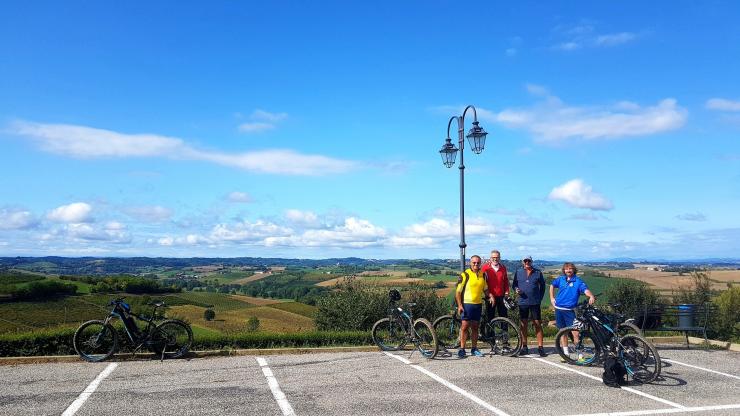
Our guide to Mountain bike trail difficulty ratings
Searching for the best mountain bike trails on the internet, we often meet codes like BC/MC/S1 or something like this:
”COUNTRY ROAD”
Elevation Gain: 1080 m;
Lenght: 22,3 km;
Difficulty: MC/BC/S2
Elevation Gain and Lenght: ok, you don't need to be a genius to understand this, but the rest? Wtf?
This codes correspond to difficulty ratings and they are supposed to give you the answer to the question “how hard would this trail or tour be”
The first thing you need to know is that up to now there is no such thing as an international officially recognised trail difficulty rating for mountain bike roads.
So, let's dig into the different rating systems:
1. Italian CAI rating system (TC, MC, BC, OC, EC)
If the trail you found is on an Italian website, very probably you have these info in the most common used scale for Italy: the CAI (Club Alpino Italiano), that divides trails in:
| TC | Touristic Skills | path on dirt roads with smooth, compact surfaces, carriage road |
| MC | Medium Skills | path on dirt with little uneven surface or slightly irregular (sheep tracks, driveways ...) or on trails with smooth, compact surfaces |
| BC | Good Skills | path on very bumpy dirt roads or mule tracks and trails with uneven surface, but still quite smooth |
| OC | Very Good Skills | as above (BC), but on trails with very bumpy and / or very uneven, with a significant presence of obstacles |
| EC | Extreme/Expert Skills | path on very irregular paths, characterised by steps and obstacles in continuous succession, that requires “trial” techniques |
Normally these acronyms are used in pairs: for example, MC/BC. The first is for the ascent, and the second for the descent. So MC/BC means that the uphill requires Medium skills while for the downhill you need to have Good Skills.
Keep also in mind that short sections attributed to a higher difficulty class should not be considered. If a MC path presents some short sections with steps evaluable in OC, the difficulty remains MC: who is not able to deal with OC can get down from the saddle and cover this small section on foot.
The evaluation is carried out considering optimal (dry) conditions.
2. Singletrail Skala (S0, S1, S2, S3, S4, S5)
Ok, but then the “S2” ?!
I told you, there is no official trail difficulty ratings: another possible (and very often used) scale is the Singletrail/skala (STS) which provides 6 degrees of ranking, from S0 to S5.
It evaluates only the technical difficulties (not the length, not elevation gain/loss) of a single trail path.
This classification, like the CAI, is independent of elements not influenced by biking technique, or rather, subjective and variable factors such as: terrain condition (mud, ice), danger (risk of falling), weather (wet, wind, fog and snow), light conditions or speed (and fire rings, and hungry tigers, and…), so you have to consider that the actual trail on a particular day can get more difficult.
In STS ranking all the following criteria are considered:
- Constitution of the trail, i.e. the grip and type of surface
- Types of obstacles
- Gradient (if applicable)
- Category of curves
- Technical demands
The STS scale:
| S0 | compact ground with good grip that does not require any special skills, wide curves and slight slope, without obstacles |
| S1 | Stretches of unsecured ground, with small roots and stones, small obstacles and sharp turns, that require basic driving skills |
| S2 | Ground for the most part not compact, protruding roots and stones with various kinds of obstacles, staircases, narrow curves that require advanced driving skills |
| S3 | technical route with protruding roots and big rocks, not compact ground with steps, hairpin bends that require a very advanced technique |
| S4 | slippery and non-compacted soil with large rocks and very tall steps, steep ramps, narrow switchbacks that require a perfect mastery of the bike |
| S5 | very technical, slippery path with steps difficult to overcome and in close sequence, tight hairpin bends, gradients over 70% that require an excellent mastery of trial-bike techniques |

Photo from: original scale in German
3. Other scales: VTOPO and IMBA
If you’re mountainbiking in France, you can find the VTOPO ranking, only dedicated to descent difficulties, from V1 (very easy) to V6 (very difficult). But why should you go mountain biking in France when you can come here to Italy with us? :)
Another scale is the IMBA (International Mountain Biking Association) Trail Difficulty Rating System: this is a basic method used to categorise the relative technical difficulty of recreation trails.
Simplifying, it's something like the “blu-red-black” classification of the ski slopes. If you want to check it out, have a look here.
Ok, we're done.
Always remember that all these acronyms and numbers are an orientation help only: choose the ones you think you are able to deal with. Sometimes, when you feel it, try to face something a little more difficult (or longer, or higher), maybe with a friend that could help (and/or teach) you.
But mountain biking is much, much more than (kilo)metres, percentages, rocks, roots, jumps and drops. The most important things is: to go out and have fun!
Want to try some trails with us?
We organise mountain bike tours of different difficulty levels, and bookings are now open!


